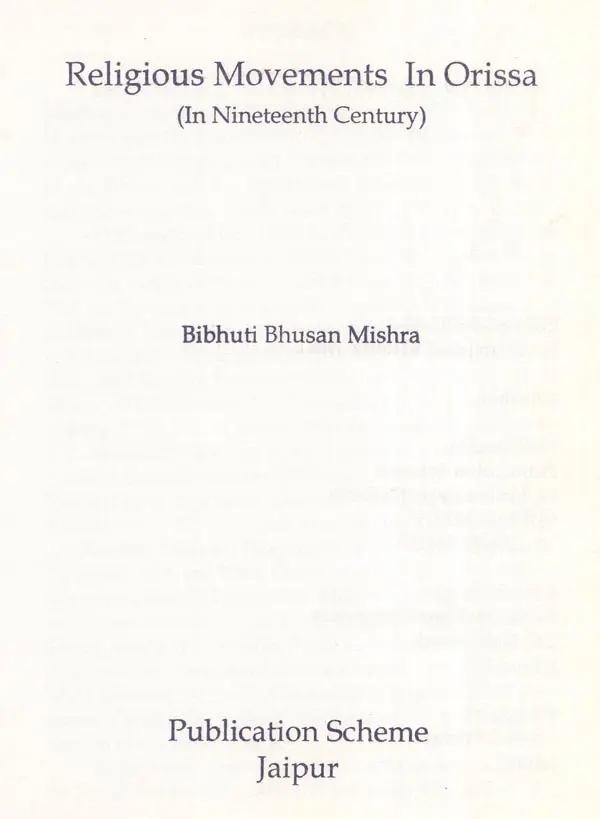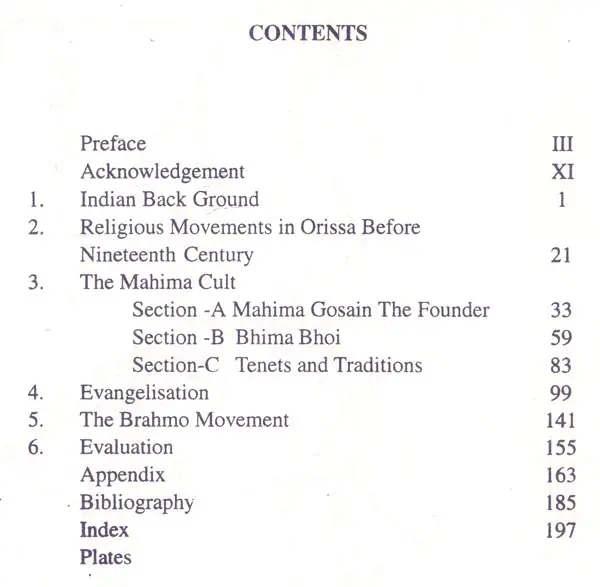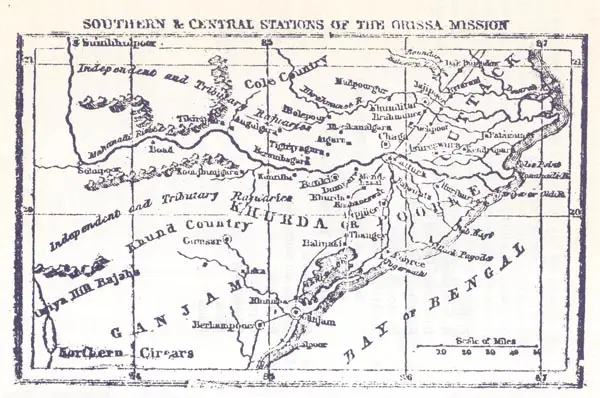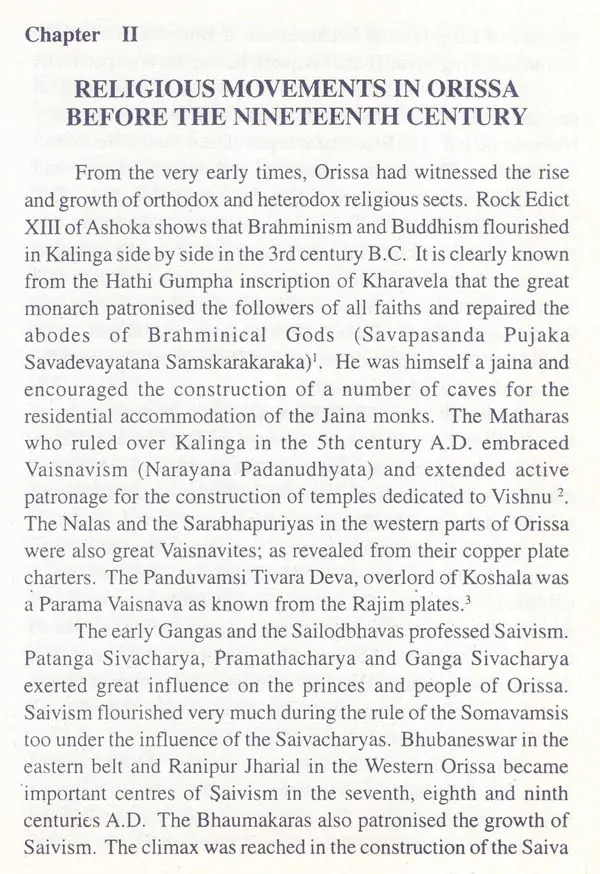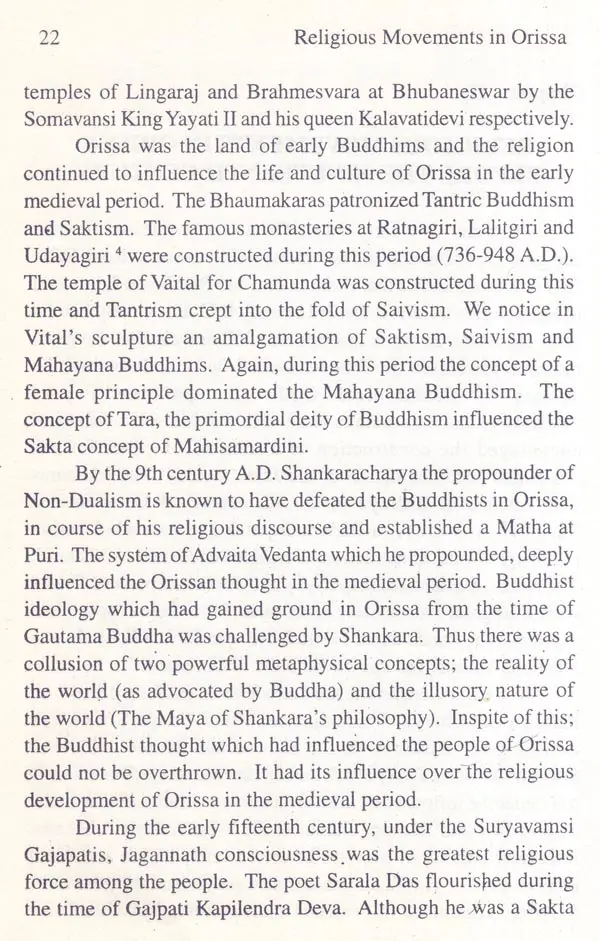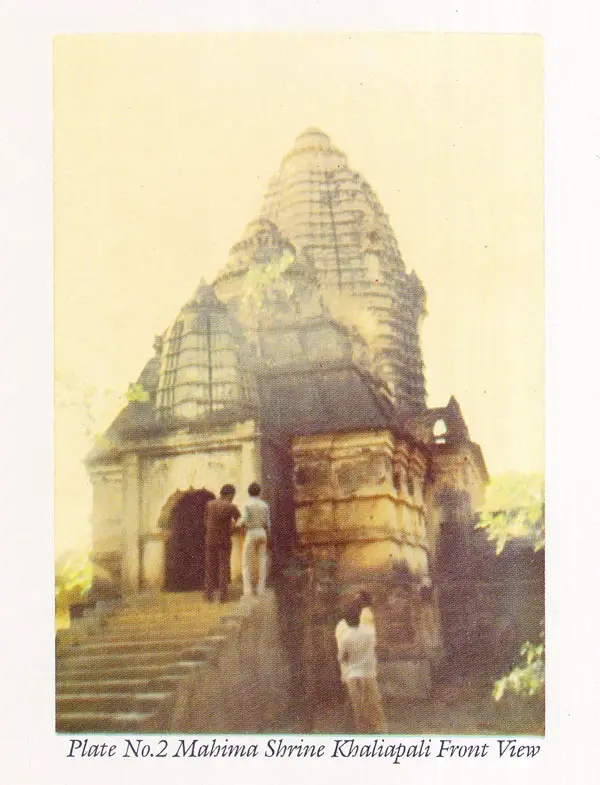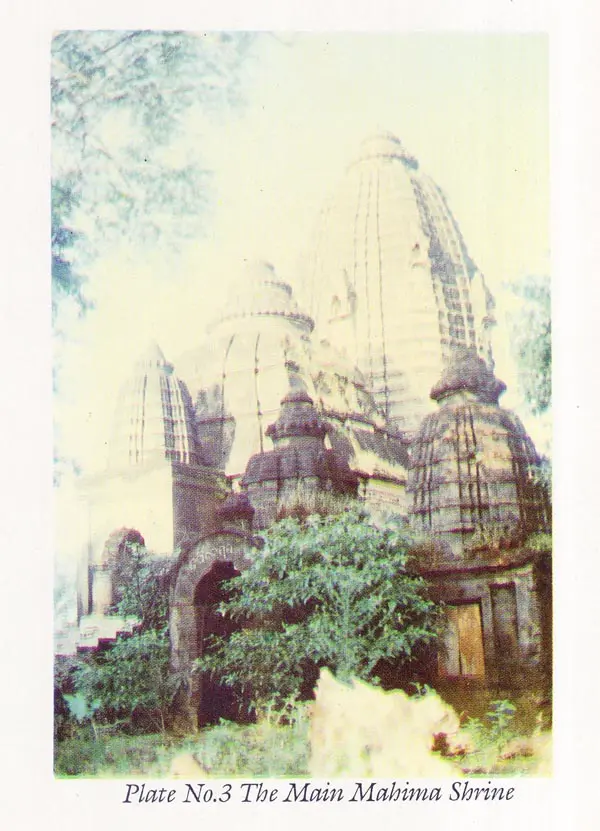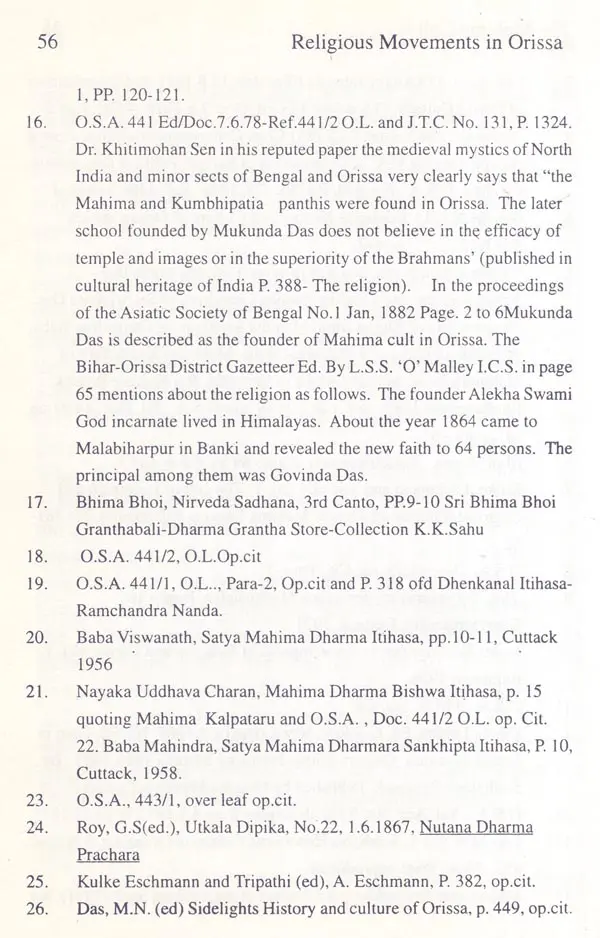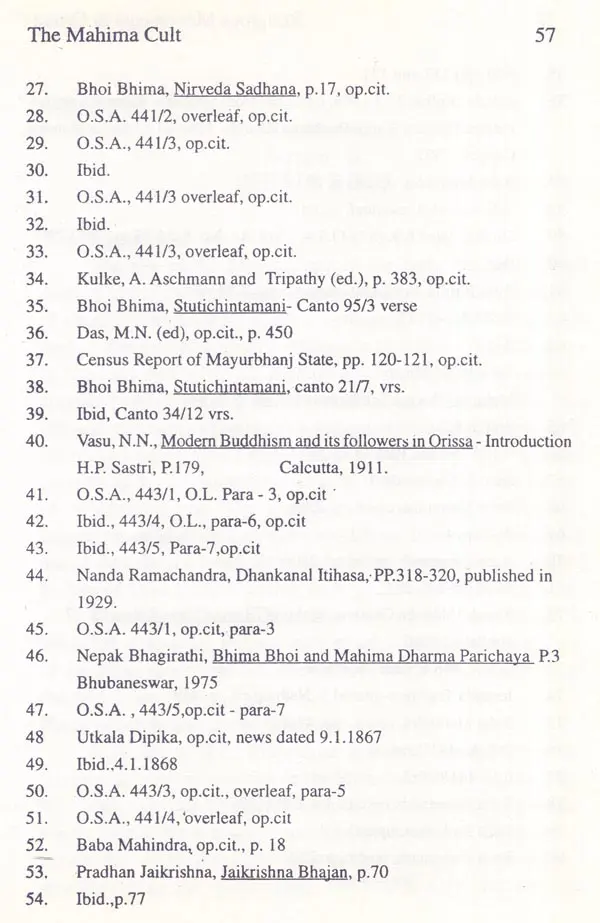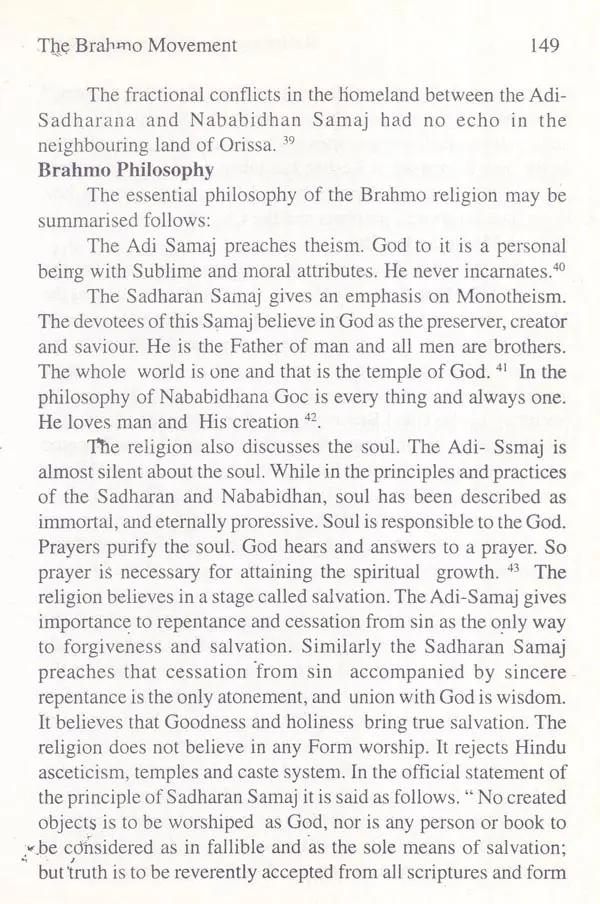
Religious Movements in Orissa : In 19th Century (An Old and Rare Book)
Book Specification
| Item Code: | UAF738 |
| Author: | Bibhuti Bhusan Mishra |
| Publisher: | Publication Scheme, Jaipur |
| Language: | English |
| Edition: | 1998 |
| ISBN: | 8186782338 |
| Pages: | 200 (Throughout Color Illustrations with 3 B/W Maps |
| Cover: | HARDCOVER |
| Other Details | 9.00 X 6.00 inch |
| Weight | 410 gm |
Book Description
This book narrates the neo religious movements in Orissa since the British occupation in 1803. It concentrates upon a deep study of the Mahima Cult as an indigenous reformative and protestant movement against the Aryanised Jagannath cult very much keeping itself within the traditions. The author has deeply and dispassionately studied Christianity, the evangelisation in Orissa and its positive contribution. The author has examined how westernised Hinduism namely the Brahmo movement born in Bengal had a short time influence on the elite of Orissa and how the language movement after 1870 for amalgamation of Oriya-speaking areas. opposed in Bengal, sealed the prospect of the Brahmo-movement in Orissa. The author has also made a valuable study of the minor cults. i.e. the Satnami and the Bisra movement in the last quarter of 19th Century in the Western part of Orissa.
The book is the first of its kind. No other book has been published on this subject. It is an improved supplement to the international standard work Modern Religeous Movements in India' by J.N.Farquhar. The author deeply analyses the total impact of various religions and the consequent growth of Oriya language, religious literature and modern growth of journalism, providing the basis for the demand of a separate province in 20th Century and growth of a new consciousness with rational response to life and society.
Bibhuti Bhusan Mishra was born in 1938 in Sonepur Raj of Orissa. He has a good academic record to his credit and did his M.A. (History) from Ravenshaw College, Cuttack of the Utkal University. He became a College lecturer in 1963 and Reader in History in 1981. The LC.S.S.R. awarded him a research grant in 1986 to work for the Doctorate degree on the Religious Movements in Orissa in the 19th Century. He got his Ph.D from the Sambalpur University in 1991. The present book is a revised version of his Thesis. He is also the author of two standard text books written in Oriya, namely, 'Maharani Victoria' and 'Sindhu Savyata." published by the Orissa Bureau of Text-book Preparation and Production. He has contributed a number of papers to reputed journals on history and culture of Orissa. he is working as Principal of a reputed college At present and has contributed critical essays to reputed journals on present education and proposed reforms.
The thesis relates to the neo-religious movements in Orissa which appeared since the British occupation in 1803. Three types of movements the Mahima cult, indigenous and reformative in character to the Jagannath cult, The western Christianity, the faith of the British and the Westernised Hinduism, the Brahmo movement have been broadly taken into the body of this work.
The founder of the Mahima cult had his first revelation at Puri in 1826 in the name of Dhulia-Baba. He propounded the theory of Alekha or Nirakara, which since 1862 was named as Mahima Dharma. A good number of scholars belonging to the faculties of History, Oriya Literature and Philosophy have been trying to explore the various aspects of the MAHIMA DHARMA since 1867. Some of their contributions are noticed in the 'Utkala Dipika' of Gouri Shankar Ray, "Proceedings of the Asiatic Society of Bengal, "Buckland's "Bengal under the Lieutenant Governors", B.C.Majumdars" Sonepur in the Sambalpur tract" and Vasu's "Modern Buddhism and the followers in Orissa".
The next group of scholars who have worked on the subject are P Mukherjee, Chittaranjan Das, Mayadhar Manasingh, Artaballabha Mohanty, Bijayananda Kara, Prahallad Pradhan, Satrughna Nath, and Nabin Kumar Sahu. The D.A.V. College at Koraput organised a Congress on "Mahima Dharma"in 1972. The papers read there threw light on the historical, philosophical and literary aspects of the religion. Pandit Viswanath Baba, the pontiff of Joranda has also given a historical account of the Mahima cult. Much lamented, Dr.(Miss) Anncharlott Eschmanna, the German research scholar of the South Asia Institute has given a critical account of this regional faith.
In the thesis, some minor religious movements organised by Sadhu Sundar Das, Ghasi Das and Bisra Munda have also been discussed in the proper context. Researches done on these religious movements may be stated as follows for a clear understanding of the scope of this thesis Sri Bhagirathi nepak and Birakishor Das have also tried to present new facts on the life of Mahima Goswami and Bhima Bhoi, the saint poet of the religion. The works of these scholars have been more or less fragmentary, and some unfortunately, have been dogmatic or merely imaginative in their build-up of facts.
For the first time an effort has been made in this dissertation. to offer a comprehensive account of the rise and growth of the Mahima cult in Orissa in the Nineteenth century. During my research I had the privilege of free access to the Mahima Tungis of Western Orissa especially that of Khaliapali. It provided me the opportunity of going through some palmleaf manuscripts in their original forms written by Sri Hari Panda and Vasudev Panda, the scribes of Bhima Bhoi's works, Stutichintamani Nirveda Sadhana and Brahma Nirupana Gita have not been properly edited. Mahima Binod. Kaliyuga Katha and Mahima Purana have not yet been published. These manuscripts are now preserved in the Khaliapali Ashram. Two manuscripts, Dharma Prakasa and Kalki Avatara, written by Hari Panda and Vasu Panda respectively have been preserved in the Sambalpur University Museum. These two have been examined with care.
The religious movements in Orissa during the 19th century no doubt reveal some local characteristics and some originality. But it must be admitted that it was part and parcel of the all india Movements witnessed during the period. So inorder to properly appreciate and evaluate the movements in orissa a discussion of these greater movements in India warrants justification.
India is a land of many old religions like Hinduism, Jainism & Buddhism in one group, Zoroastrianism and Mauhammadanism and early medieval Vaisnavism in the second group, and the growth of Christian Mission of Evangelisation in the third group. In the 19th century a good number of religions raised their heads on the Indian soil. They may be grouped under movements favouring drastie reforms like the Brahmo and Prarthana Samaj under the grab of Hinduism and the Parsee and the Muhammadan Reform under the Western influence. These movements had a great impact all over India from 1828 to 1913. The next group of religious movements which were seen after 1870 stood for the defence of the old faith. The Arya Samaj, the Vedic mission, the Chet Ramai movement, Radhaswami Satsang and the Deva Samaj may be included in this group. The Ahamadiyas of Quadian, the Nazarene New Church and the Isamoshipanthis can also be brought under this group. In the next group we see the full defence of the old religions the Ramakrishna mission and the Sectarian movements in Hinduism which may be called as the revival of Vaisnavism and Saivism.
These movements had their seeds in the old religions. But it is a fact that Christian Mission played a very important part in shaping the new outlook of the religious movements in the 19th century India came under the Muhammadan invasions during the 12th century. The Muslim Rule or early British administration seldom succeeded in giving peace to the people. For about six hundred years peace was almost lost as there was frequent fighting. In the 18th century India was mostly in a miserable state of poverty and pitiable plight.
The East India Company came to India exclusively for Commerce. In order to make their commerce successful they had necessity for a stable and just government. India suffered from a conflict between the Muslims and the Hindus. Hinduism, which was religion of almost three-fourth of the population consisted of two great sects, vaisnavites and the saivites, holding Visnu and Siva as their chief Gods. Both the sects recognise the existence of all other divinities of the Hindu pantheon. A special group of the Sivaite sect pays honour to the consort of Siva, Kali or Durga. The Visnuites worship idols and sivaites the phallus symbol. Both the sects give importance to Guru-puja i.e. worshipping the preachers of the 'dharma'. Right from the 16th to the end of 18th century the true spiritual thinkers remained isolated from the population, lived in the quietest jungles coming very sparingly into the society as wandering celebate ascetics. The common man followed only the worship of coarse idolatry.
**Contents and Sample Pages**
